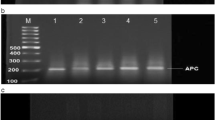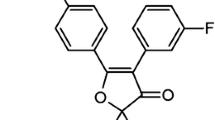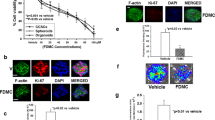Abstract
Licochalcone A (LicA), a major phenolic constituent of licorice, has antiproliferative and anti-inflammatory properties in human and murine cell lines. We previously showed that LicA down-regulates the expression of cyclooxygenase (COX)-2 and inducible nitric oxide synthase (iNOS) via the modulation of nuclear factor-κB and activator protein-1 activation in cell culture. We therefore tested whether LicA inhibits carcinogenesis and metastasis in mouse models. To induce colon carcinogenesis, C57BL/6 mice were given a single intraperitoneal injection of azoxymethane (10 mg/kg body weight), followed by 1% dextran sulfate sodium in the drinking water. Additionally, we also assessed the effect of LicA on liver metastasis by intrasplenic injection of BALB/c mice with CT-26 cells. Feeding the mice with LicA (5, 15, and 30 mg/kg body weight) significantly reduced tumor formation as well as the number of cells expressing proliferating cell nuclear antigen, β-catenin, COX-2, and iNOS in the colon. LicA also decreased colon levels of proinflammatory cytokines and chemokines. In addition, LicA significantly increases survival of animals and inhibited liver metastasis as well as the expression of matrix metalloproteinase-9 in the liver. These preclinical studies indicate that LicA has potent antitumor and antimetastatic activity, suggesting that LicA could increase efficacy and improve patient outcomes in colorectal cancer.






Similar content being viewed by others
References
Jemal A, Siegel R, Ward E, Hao Y, Xu J, Thun MJ (2009) Cancer statistics, 2009. CA Cancer J Clin 100:225–249
Korea National Statistical Office (2007) Annual report of the cause and death statistics. Korea National Statistical Office, Korea
Coussens LM, Werb Z (2002) Inflammation and cancer. Nature 420:60–67
Parkin DM (2006) The global health burden of infection-associated cancers in the year 2002. Int J Cancer 118:3030–3044
Ahmadi A, Polyak S, Draganov PV (2009) Colorectal cancer surveillance in inflammatory bowel disease: the search continues. World J Gastroenterol 15:61–66
Clevers H (2004) At the crossroads of inflammation and cancer. Cell 118:671–674
Balkwill F, Mantovani A (2001) Inflammation and cancer: back to Virchow? Lancet 357:539–545
Mandayam S, Huang R, Tarnawski AS, Chiou SK (2007) Roles of survivin isoforms in the chemopreventive actions of NSAIDS on colon cancer cells. Apoptosis 12:1109–1116
Koehne CH, Dubois RN (2004) COX-2 inhibition and colorectal cancer. Semin Oncol 31:12–21
Gardner SH, Hawcroft G, Hull MA (2004) Effect of nonsteroidal anti-inflammatory drugs on beta-catenin protein levels and catenin-related transcription in human colorectal cancer cells. Br J Cancer 91:153–163
Bertagnolli MM (2007) Chemoprevention of colorectal cancer with cyclooxygenase-2 inhibitors: two steps forward, one step back. Lancet Oncol 8:439–443
Lee JC, Lee KY, Son YO, Choi KC, Kim J, Truong TT, Jang YS (2005) Plant-originated glycoprotein, G-120, inhibits the growth of MCF-7 cells and induces their apoptosis. Food Chem Toxicol 43:961–968
Kim JK, Oh SM, Kwon HS, Oh YS, Lim SS, Shin HK (2006) Anti-inflammatory effect of roasted licorice extracts on lipopolysaccharide-induced inflammatory responses in murine macrophages. Biochem Biophys Res Commun 345:1215–1223
Sun Pan B, Kuo YY, Chen TY, Liu YC (2005) Anti-oxidative and anti-inflammatory activities of two different species of a Chinese herb I-Tiao-Gung. Life Sci 77:2830–2839
Lu QY, Jin YS, Zhang Q, Zhang Z, Heber D, Go VL, Li FP, Rao JY (2004) Ganoderma lucidum extracts inhibit growth and induce actin polymerization in bladder cancer cells in vitro. Cancer Lett 216:9–220
Treasure J (2005) Herbal medicine and cancer: an introductory overview. Semin Oncol Nurs 21:177–183
Rafailov S, Cammack S, Stone BA, Katz AE (2007) The role of Zyflamend, an herbal anti-inflammatory, as a potential chemopreventive agent against prostate cancer: a case report. Integr Cancer Ther 6:74–76
Chen Y, Miao ZH, Zhao WM, Ding J (2005) The p53 pathway is synergized by p38 MAPK signaling to mediate 11,11′-dideoxyverticillin-induced G2/M arrest. FEBS Lett 579:3683–3690
Murakami A, Miyamoto M, Ohigashi H (2004) Zerumbone, an anti-inflammatory phytochemical, induces expression of proinflammatory cytokine genes in human colon adenocarcinoma cell lines. Biofactors 21:95–101
Seeram NP, Adams LS, Hardy ML, Heber D (2004) Total cranberry extract versus its phytochemical constituents: antiproliferative and synergistic effects against human tumor cell lines. J Agric Food Chem 52:2512–2517
Shibata S (2000) A drug over the millennia: pharmacognosy, chemistry, and pharmacology of licorice. Yakugaku Zasshi 120:849–862
Haraguchi H, Tanimoto K, Tamura Y, Mizutani K, Kinoshita T (1999) Mode of antibacterial action of retrochalcones from Glycyrrhiza inflata. Phytochemistry 48:125–129
Kwon HS, Park JH, Kim DH, Kim YH, Park JH, Shin HK, Kim JK (2008) Licochalcone A isolated from licorice suppresses lipopolysaccharide-stimulated inflammatory reactions in RAW264.7 cells and endotoxin shock in mice. J Mol Med 86:1287–1295
Rafi MM, Rosen RT, Vassil A, Ho CT, Zhang H, Ghai G, Lambert G, DiPaola RS (2000) Modulation of bcl-2 and cytotoxicity by licochalcone-A, a novel estrogenic flavonoid. Anticancer Res 20:2653–2658
Rafi MM, Vastano BC, Zhu N, Ho CT, Ghai G, Rosen RT, Gallo MA, DiPaola RS (2002) Novel polyphenol molecule isolated from licorice root (Glycyrrhiza glabra) induces apoptosis, G2/M cell cycle arrest, and bcl-2 phosphorylation in tumor cell lines. J Agric Food Chem 50:677–684
Popivanova BK, Kitamura K, Wu Y, Kondo T, Kagaya T, Kaneko S, Oshima M, Fujii C, Mukaida N (2008) Blocking TNF-alpha in mice reduces colorectal carcinogenesis associated with chronic colitis. J Clin Invest 118:560–570
Lopez-Barcons LA, Zhang J, Siriwitayawan G, Burke TG, Perez-Soler R (2004) The novel highly lipophilic topoisomerase I inhibitor DB67 is effective in the treatment of liver metastases of murine CT-26 colon carcinoma. Neoplasia 6:457–467
Fiala ES (1977) Investigations into the metabolism and mode of action of the colon carcinogens 1,2-dimethylhydrazine and azoxymethane. Cancer 40:2436–2445
Tanaka T, Suzuki R, Kohno H, Sugie S, Takahashi M, Wakabayashi K (2005) Colonic adenocarcinomas rapidly induced by the combined treatment with 2-amino-1-methyl-6-phenylimidazo[4,5-b]pyridine and dextran sodium sulfate in male ICR mice possess β-catenin gene mutations and increases immunoreactivity for β-catenin, cyclooxygenase-2, and inducible nitric oxide synthase. Carcinogenesis 26:229–238
Kohno H, Suzuki R, Sugie S, Tanaka T (2005) β-Catenin mutations in a mouse model of inflammation-related colon carcinogenesis induced by 1,2-dimethylhydrazine and dextran sodium sulfate. Cancer Sci 96:69–76
Collins HM, Morris TM, Watson SA (2001) Spectrum of matrix metalloproteinase expression in primary and metastatic colon cancer: relationship to the tissue inhibitors of metalloproteinases and membrane type-1-matrix metalloproteinase. Br J Cancer 84:1664–1670
Watson SA, Morris TM, Robinson G, Crimmin MJ, Brown PD, Hardcastle JD (1995) Inhibition of organ invasion by the matrix metalloproteinase inhibitor batimastat (BB-94) in two human colon carcinoma metastasis models. Cancer Res 55:3629–3633
Clapper ML, Cooper HS, Chang WC (2007) Dextran sulfate sodium-induced colitis-associated neoplasia: a promising model for the development of chemopreventive interventions. Acta Pharmacol Sin 28:1450–1459
Tanaka T, Kohno H, Suzuki R, Yamada Y, Sugie S, Mori H (2003) A novel inflammation-related mouse colon carcinogenesis model induced by azoxymethane and dextran sodium sulfate. Cancer Sci 94:965–973
Ying L, Marino J, Hussain SP, Khan MA, You S, Hofseth AB, Trivers GE, Dixon DA, Harris CC, Hofseth LJ (2005) Chronic inflammation promotes retinoblastoma protein hyperphosphorylation and E2F1 activation. Cancer Res 65:9132–9136
Chen R, Rabinovitch PS, Crispin DA, Emond MJ, Bronner MP, Brentnall TA (2005) The initiation of colon cancer in a chronic inflammatory setting. Carcinogenesis 26:1513–1519
Di Pace RF, Massa S, Ribeiro OG, Cabrera WH, De Franco M, Starobinas N, Seman M, Ibañez OC (2006) Inverse genetic predisposition to colon versus lung carcinogenesis in mouse lines selected based on acute inflammatory responsiveness. Carcinogenesis 27:1517–1525
Thun MJ, Henley SJ, Patrono C (2002) Nonsteroidal anti-inflammatory drugs as anticancer agents: mechanistic, pharmacologic, and clinical issues. J Natl Cancer Inst 94:252–266
Choo MK, Sakurai H, Kim DH, Saiki I (2008) A ginseng saponin metabolite suppresses tumor necrosis factor-alpha-promoted metastasis by suppressing nuclear factor-kappaB signaling in murine colon cancer cells. Oncol Rep 19:595–600
Liu HY, Huang ZL, Yang GH, Lu WQ, Yu NR (2008) Inhibitory effect of modified citrus pectin on liver metastases in a mouse colon cancer model. World J Gastroenterol 14:7386–7391
Lee HJ, Lee EO, Rhee YH, Ahn KS, Li GX, Jiang C, Lü J, Kim SH (2006) An oriental herbal cocktail, ka-mi-kae-kyuk-tang, exerts anti-cancer activities by targeting angiogenesis, apoptosis and metastasis. Carcinogenesis 27:2455–2463
Sato H, Seiki M (1993) Regulatory mechanism of the 92 kDa type IV collagenase gene expression which is associated with invasiveness of tumor cells. Oncogene 8:395–405
Joyce JA, Pollard JW (2009) Microenvironmental regulation of metastasis. Nat Rev Cancer 9:239–252
John A, Tuszynski G (2007) The role of matrix metalloproteinases in tumor angiogenesis and tumor metastasis. Pathol Oncol Res 7:14–23
Gerg M, Kopitz C, Schaten S, Tschukes A, Kahlert C, Stangl M, von Weyhern CW, Brücher BL, Edwards DR, Brand K, Krüger A (2008) Distinct functionality of tumor cell-derived gelatinases during formation of liver metastases. Mol Cancer Res 6:341–351
Hanahan D, Weinberg RA (2000) The hallmarks of cancer. Cell 100:57–70
Mantovani A (2009) Cancer: inflaming metastasis. Nature 457:36–37
Dey A, Tergaonkar V, Lane DP (2008) Double-edged swords as cancer therapeutics: simultaneously targeting p53 and NF-kappaB pathways. Nat Rev Drug Discov 7:1031–1040
Gaur U, Aggarwal BB (2003) Regulation of proliferation, survival and apoptosis by members of the TNF superfamily. Biochem Pharmacol 66:1403–1408
Fu Y, Hsieh TC, Guo J, Kunicki J, Lee MY, Darzynkiewicz Z, Wu JM (2004) Licochalcone-A, a novel flavonoid isolated from licorice root (Glycyrrhiza glabra), causes G2 and late-G1 arrests in androgen-independent PC-3 prostate cancer cells. Biochem Biophys Res Commun 322:263–270
Acknowledgment
This work was supported by a Korea Science and Engineering Foundation (KOSEF) grant funded by the Korean government (MOST; R01-2007-000-20164).
Conflict of interest statement
The authors declare that they have no conflict of interests.
Author information
Authors and Affiliations
Corresponding authors
Electronic supplementary material
Below is the link to the electronic supplementary material.
Supplementary Figure 1
Microscopic view of the colon on day 56 after AOM injection. Representative microscopic pictures of the H&E staining showing the effect of LicA on tumorigeneis. Arrow indicates infilteration of inflammatory cells. Original magnification, ×40 (upper panel), ×200 (middle panel), and ×400 (lower panel). (PDF 217 kb)
Rights and permissions
About this article
Cite this article
Kim, JK., Shin, E.K., Park, J.H. et al. Antitumor and antimetastatic effects of licochalcone A in mouse models. J Mol Med 88, 829–838 (2010). https://doi.org/10.1007/s00109-010-0625-2
Received:
Revised:
Accepted:
Published:
Issue Date:
DOI: https://doi.org/10.1007/s00109-010-0625-2




